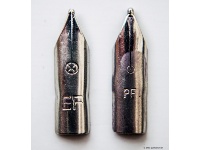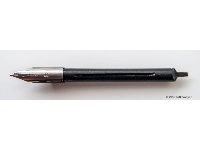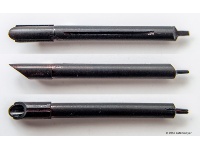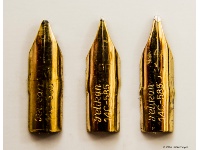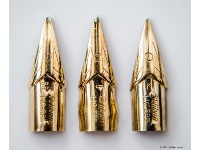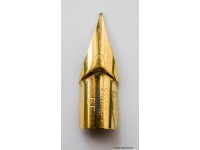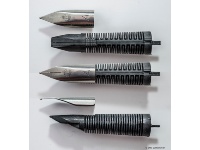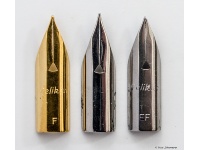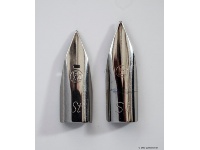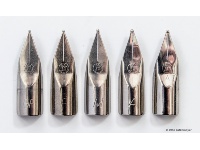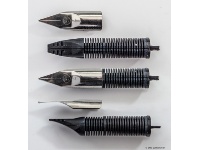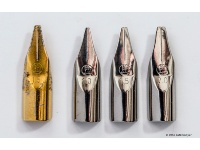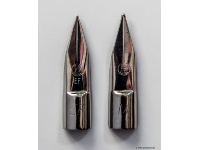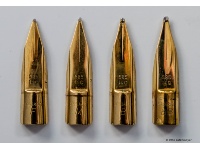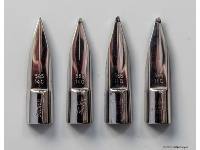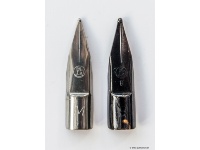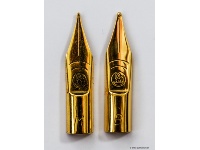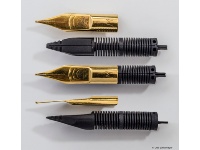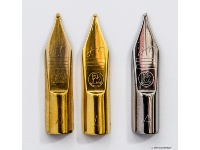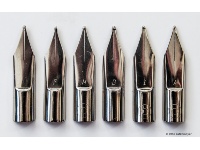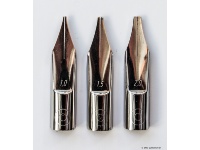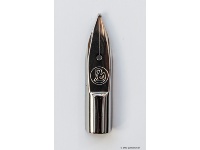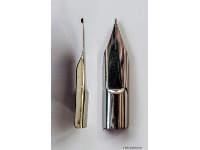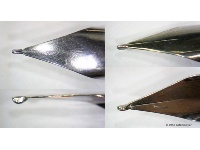- Summary
- Covered nibs 1958 - 1965
- Half-covered nibs 1965 - 1968
- Nibs 1969 - 1978
- Special nibs for shorthand 1971 - 2000
- Nibs starting from 1979
- Nibs of the series Signum from 1979 and the Colani-pen P80 (1989)
- Nibs of the series GO! from 1992
- Nibs of the learning to write pen Pelikan junior from 1993 to 2001
- Nibs of the LEVEL series from 1996
- Nibs from 1998 until today
Summary
With two new developments of Theodor Kovács in 1958 Pelikan started a new period of history has evolved continuously up to the present: the inner feed with a plug-in nib and ink cartridges.
- In 1955 Kovacs developed the inner conductive ink feed with Thermic regulator
- In 1956 Pelikan was working on the development of ink cartridges
- February 1957 the patent for the ink cartridge applied (patent is issued 6/1959)
- In 1958, the patent for the thermic controller is issued and acquired by Pelikan
- September 1958 come the piston fountain pen P1S and P1RG with this new thermic-controller on the market
- March 22, 1960, the Pelikano (model 1) as a new fountain pen was presented (first cartridge pen)
- July 31, 1961 Pelikan brought the P15 / P25 cartridge pens for Adults on the market
- In 1965 the form of the nib was revised (only half covered) for the Pelikano and new piston fountain pens as well as cartridge pens for adults with this nib was offered
- In 1969 a further adjustment of the nib shape and the pen models
- In the 1970s nibs for special models like the Steno-fountain pens and the Primapenna was introduced
- In 1979 the Pelikano Model 5receives a new nib shape which is also in the following years in many other model series in use
- In 1979 a modified nib of the Pelikano is used for the Signum series
- From 1992 is a further modified style of nib for the Signum model used at the youth filler GO!, which finds its application in their basic style until today. With slight modifications they can also be found in the models of the Pelikano juniors, the Level-Line, the series Pura and Dion and Happy Pen again.
This report aims to describe the development of plug-in nibs from 1958 to the present and list the fountain pen models in which these nibs were used in each case. The following illustration of fountain pens showing a cross-section of the development of this nibs.
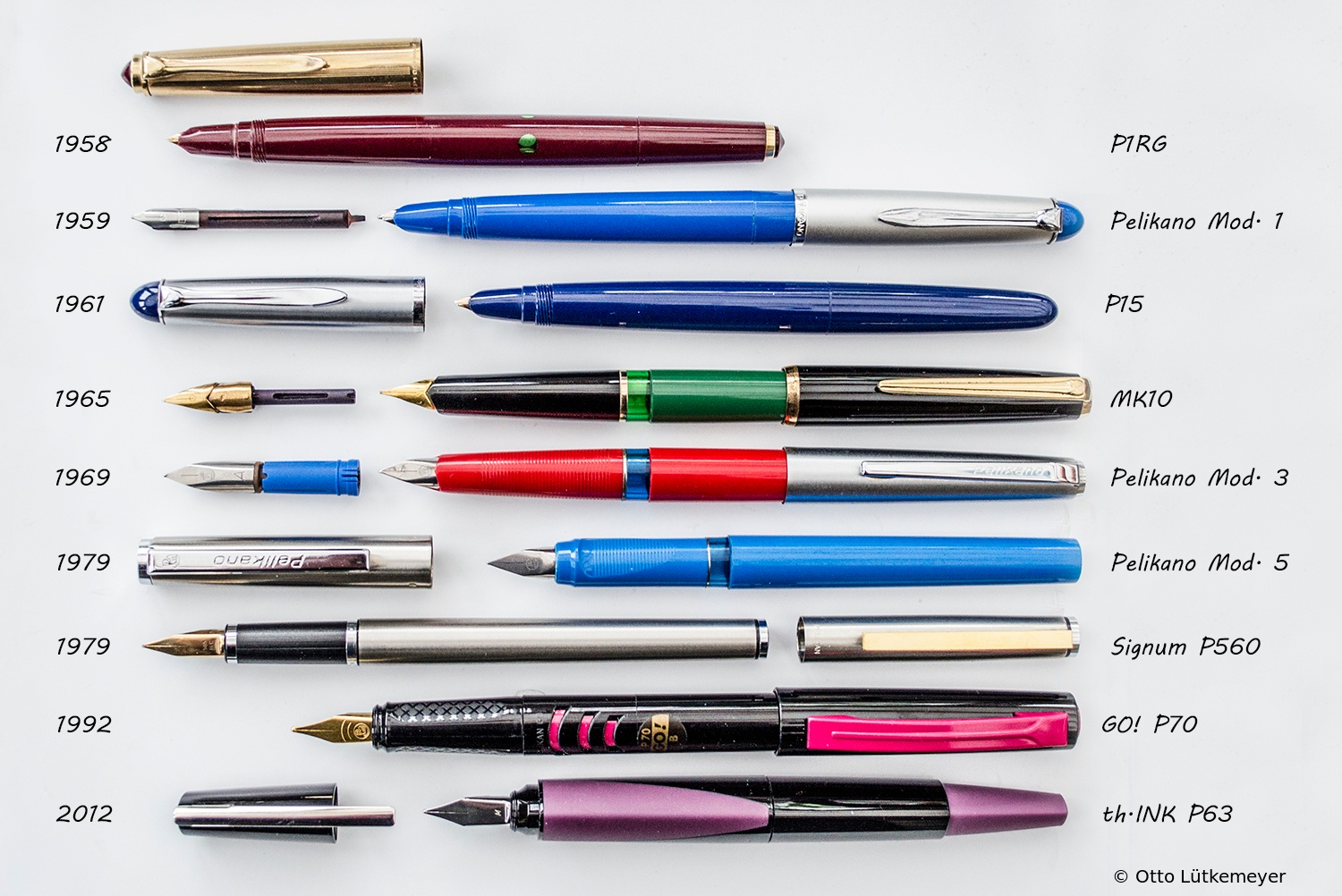
Overview of the development
Covered nibs 1958 - 1965
With the ![]() piston fillers P1 (P1RG = Rolled Gold and P1S = Silvexa) Pelikan started a new period in the construction of nibs and feeds for fountain pens.
piston fillers P1 (P1RG = Rolled Gold and P1S = Silvexa) Pelikan started a new period in the construction of nibs and feeds for fountain pens.
In 1955 Theodor Kovács had developed a new inner conductive ink feed, which also included a large reservoir for excess ink. Pelikan took over this patent (![]() link to pdf file) of 4 June 1958, and on 2 September 1958 brought out a piston filler with the P1 'Pelikan thermic-regulator'.
link to pdf file) of 4 June 1958, and on 2 September 1958 brought out a piston filler with the P1 'Pelikan thermic-regulator'.
The 14 ct gold nib of this filler was completely covered. These nibs came in the widths EF, F, M, B, BB, OF, OM, OB, OBB and as a special steno nib (ST), as well as nibs for carbon copies by letter (D) and ball point fine and medium (KF and KM).
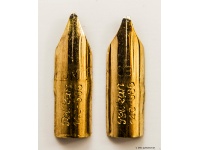
14 ct gold nib 1958
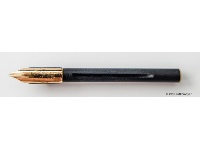
Gold nib with ink feed
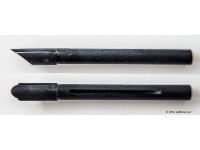
Ink feed piston filler
(Part of the Pelikan-thermic-regulator)
Almost simultaneously, Pelikan had been developing an ink cartridge for a fountain pen since 1956, and applied for a patent for this development in February 1957 (![]() Link to pdf-file).
Link to pdf-file).
On March 22, 1960 Pelikan launched the first ![]() Pelikano as a new fountain pen, after about one year of development. It corresponded to the P1 except for the cap and the color. It was the first Pelikan fountain pen to possess a system that allowed a clean filling of the pen with ink.
Pelikano as a new fountain pen, after about one year of development. It corresponded to the P1 except for the cap and the color. It was the first Pelikan fountain pen to possess a system that allowed a clean filling of the pen with ink.
Instead of a gold nib like the P1, the Pelikano had a steel nib similar in style to the P1's. The nibs were offered in the widths EF, F, M, O and as pan nib (Pfannenfeder, PF), which were offered only for the school fountain pen. The ink feed for this cartridge pen, compared to the piston filler, was extended by a spur on the inner end of the feed which jutted into the opened ink cartridge in the barrel of the pen.
Following the success of the Pelikano two identical ![]() cartridge pens for adults came on the market with the P15 and P25 on 31 July 1961. These pens differed only in color and material from the Pelikano and were equipped with 14 ct gold nibs, like the P1. However, these gold nibs had been slightly modified. The nibs wings were further retracted slightly and thus the nibs became a little longer. While the nibs of the P15 / P25 could also be used in P1, conversely, the nibs of P1 were not suitable for the P15 / P25. For the P15 / P25, the same nib widths as in P1 were available, with the exception of special nibs KF and KM.
cartridge pens for adults came on the market with the P15 and P25 on 31 July 1961. These pens differed only in color and material from the Pelikano and were equipped with 14 ct gold nibs, like the P1. However, these gold nibs had been slightly modified. The nibs wings were further retracted slightly and thus the nibs became a little longer. While the nibs of the P15 / P25 could also be used in P1, conversely, the nibs of P1 were not suitable for the P15 / P25. For the P15 / P25, the same nib widths as in P1 were available, with the exception of special nibs KF and KM.
Half-covered nibs 1965 - 1968
Suggestions from educators and scientific evidence led to a further development at Pelikan of the Pelikano pen. The nib was now larger, more flexible and was only half covered. The feed was adapted to the new shape of the nibs. The nib of this ![]() Pelikano (Model 2) was still available as a steel nib in sizes EF, F, M, O and PF.
Pelikano (Model 2) was still available as a steel nib in sizes EF, F, M, O and PF.
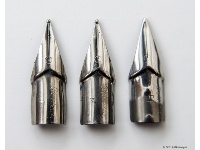
Pelikano steel nib 1965
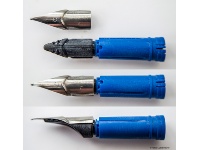
Nib with ink feed
and Pelikan-thermic-regulator
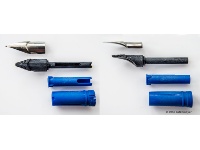
Construction of the Pelikan-thermic-regulators
The fountain pen for adults got a new, half-hidden nib in new models from 1965. There were both piston fillers and cartridge pens with this pen shape and the conductive ink feed. The ink feed no longer differed between piston and cartridge fillers.
Some models were offered with a 14 ct gold nib. This gold nib was provided at the outer edge with a fine embossed line, so that they were easier to distinguish from the gold plated nibs.
Gold nibs were used for the ![]() piston filler M20 (Febuary 1965), MK20 (May 1966), M25 (1966), M30 (February 1965), MK30 (1966), M60 (February 1965), M100 (February 1966), M30S (1967) and
piston filler M20 (Febuary 1965), MK20 (May 1966), M25 (1966), M30 (February 1965), MK30 (1966), M60 (February 1965), M100 (February 1966), M30S (1967) and ![]() cartridge pens P20 (February 1965), P25 (May 1966), P30 (February 1965).
cartridge pens P20 (February 1965), P25 (May 1966), P30 (February 1965).
Other models were equipped with a gold-plated steel nib. These included the ![]() piston filler M10 (ca. 1967), MK10 (March 1967) and 120 (1967/68), M10S (1967) and the
piston filler M10 (ca. 1967), MK10 (March 1967) and 120 (1967/68), M10S (1967) and the ![]() cartridge pen P12 (February 1965).
cartridge pen P12 (February 1965).
There are also 18 ct gold nibs known that originate from export models for France.
Nibs 1969 - 1978
The next improvement of the nib of the ![]() Pelikano was carried out in 1969 with the Model 3. The nib is even more visible, the lateral edges more acutely angeled. The nib has high stability under pressure, but remained elastic.
Pelikano was carried out in 1969 with the Model 3. The nib is even more visible, the lateral edges more acutely angeled. The nib has high stability under pressure, but remained elastic.
With the A-nib (A = beginner, german "Anfänger") a new nib for writing beginners was placed on the market. The cut of this nib is oriented such that for the inexperienced writer, a changing grip on the pen and changing angle of the pen to the paper does not cause problems. In addition to this A-nib Pelikano steel nibs continued to be available in widths EF, F and M.
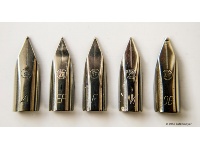
Pelikano steel nibs 1969
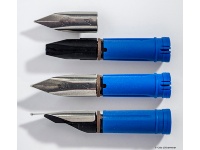
Nib with feed and
Pelikan-thermic-regulator
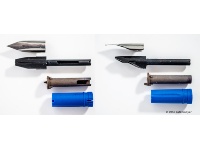
Structure of the Pelikan
thermic-regulator
While in the first models from 1958 the ink feed can be withdrawn as part of the three-part thermic controller, this is no longer possible with the new models from 1969. The ink feed was slightly modified and adapted to the new shape of the nib and fitted with the Pelikan thermic regulator firmly into the grip section. To change the nib, only the nib is pulled out, while the ink feed remains firmly in the grip section.
Circa 1971, the construction of the thermic-regulator changed in secret, while the nib shape remained unchanged. The previously multipart thermic controller with ink feed was now made of one piece and continued to be permanently installed in the grip section.
Pelikan Milan introduced the fountain pen ![]() Primapenna, produced by the company Merz & Krell, in the early 1970s. These pens hat the nib form of the 1969 Pelikano. But they differed from the Pelikano in having a triangular air hole. The first nibs consisted of gold-plated steel, but later only stainless steel nibs were used.
Primapenna, produced by the company Merz & Krell, in the early 1970s. These pens hat the nib form of the 1969 Pelikano. But they differed from the Pelikano in having a triangular air hole. The first nibs consisted of gold-plated steel, but later only stainless steel nibs were used.
The advantages of the new nib were also adopted in 1969 in all new cartridge pens for adults and from September 1970, for the Piston filler, too. For these pens, apart from the nib widths of the Pelikano, nib were also available as B, BB, OM, OB.
They were build in as 14 ct gold nib in the ![]() piston filler model M20 (September 1970), MK20 (White Gold / 1969), M21 (January 1971) and in the
piston filler model M20 (September 1970), MK20 (White Gold / 1969), M21 (January 1971) and in the ![]() cartridge pen P21 (white gold / September 1969) or P485 (white gold / October 1973), P28 (January 1971) or P482 (October 1973), P30 (1969), P60 (1969), P477 (1973) and P488 (1973). Individual models such as the M30, M60, M100, P30 or P490 (October 1973), P60 or P495 (October 1973) were equipped with a 18 ct gold from August 1970.
cartridge pen P21 (white gold / September 1969) or P485 (white gold / October 1973), P28 (January 1971) or P482 (October 1973), P30 (1969), P60 (1969), P477 (1973) and P488 (1973). Individual models such as the M30, M60, M100, P30 or P490 (October 1973), P60 or P495 (October 1973) were equipped with a 18 ct gold from August 1970.
Gold plated steel nibs were found in the models MK10 (September 1970), M480 (February 1973), M480S (1973), P12 (1969) and stainless steel nibs in the models P18 (January 1972) and P478 (October 1973), P474 (October 1973 ), P476 (January 1973), P479 (1973).
Also all special M4xx models that were equipped with ink converters made for the Japanese market are optionally equipped with gold or steel nibs of this series.
Steel nibs of this type were also used in the partially later model series for ![]() school/youngsters and
school/youngsters and ![]() adults Lady Pen P452 (1973), Happy Pen P472 (1973), Disco P455 (1978), GTI P469 (1985) and Nobil P38 (plated steel nib / 1988).
adults Lady Pen P452 (1973), Happy Pen P472 (1973), Disco P455 (1978), GTI P469 (1985) and Nobil P38 (plated steel nib / 1988).
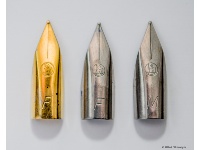
gold plated steel nibs and
steel nibs 1969
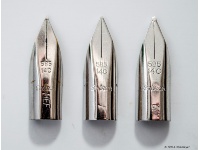
14 ct white gold nibs 1969
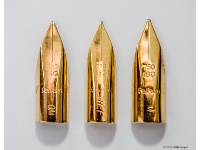
Yellow gold 14 ct (1969)
and 18 ct (starting 1970)
Special nibs for shorthand 1971 - 2000
Until the introduction of the special ![]() steno pen P16 (Feb 1971) and P11 (Feb 1972)there were steno nibs (ST) for the standard fountain pens for adults, e.g. P15, M30 and many more. The new steno fountain pens were equipped with nibs, which corresponded to the basic shape of the nibs from 1969. The nibs had the marking St (= Steno) and to better distinguish them an oval breather hole. The model P470 of October 1973 was also equipped with the same nib.
steno pen P16 (Feb 1971) and P11 (Feb 1972)there were steno nibs (ST) for the standard fountain pens for adults, e.g. P15, M30 and many more. The new steno fountain pens were equipped with nibs, which corresponded to the basic shape of the nibs from 1969. The nibs had the marking St (= Steno) and to better distinguish them an oval breather hole. The model P470 of October 1973 was also equipped with the same nib.
All other Steno successor models P470 1983-2000 had a slightly altered Steno-nib: the basic shape of the nib was unchanged, but slightly longer and no longer had an oval breather hole.
Nibs starting from 1979
In 1979 the nib design for the ![]() Pelikano Model 5 changed again and this design was kept for all following Pelikano series up to 2003. The round back of the feed makes its transition to the front flat part under the nib through a slight bevel. The bent nib wings are pulled back. The feed was modified.
Pelikano Model 5 changed again and this design was kept for all following Pelikano series up to 2003. The round back of the feed makes its transition to the front flat part under the nib through a slight bevel. The bent nib wings are pulled back. The feed was modified.
From about 1989, an L-pen for left-handers was introduced for all Pelikano models.
For many other pens the stainless steel nibs of that design was used. These include the series of ![]() youth fillers Twist P10 and P20 (1986), Culture Pen P20 (from 1990), Pen Collection P21 (since 1992), Moovie Pen P22 (1992), Nature Pen M22 (1994), Culture Pen P22 ( since 1996) and P22 (from 2001) and the Super Pirate Pen P25 (from 1991).
youth fillers Twist P10 and P20 (1986), Culture Pen P20 (from 1990), Pen Collection P21 (since 1992), Moovie Pen P22 (1992), Nature Pen M22 (1994), Culture Pen P22 ( since 1996) and P22 (from 2001) and the Super Pirate Pen P25 (from 1991).
Among the fountain pens for ![]() adults are the cartridge pen AirPen P458 (1981) and P459 (1984) which contain these stainless steel nibs.
adults are the cartridge pen AirPen P458 (1981) and P459 (1984) which contain these stainless steel nibs.
Starting from 1989, cartridge pens for ![]() calligraphy were offered with the Script P50. The nibs conformed to this basic form and were without writing grain in widths of 1 mm, 1.5 mm and 2 mm. Usually the Script used the stainless steel nibs, though one of the script models is equipped with a gold-plated nib.
calligraphy were offered with the Script P50. The nibs conformed to this basic form and were without writing grain in widths of 1 mm, 1.5 mm and 2 mm. Usually the Script used the stainless steel nibs, though one of the script models is equipped with a gold-plated nib.
Nibs of the series Signum from 1979 and the Colani-pen P80 (1989)
For the fountain pen of the ![]() Signum series whose first models came on the market from September 1979, a modified variant of the nib form of Pelikano 1979 was used. The round plug part of the nib is bent over sharply to the visible, the flat part of the nib. The nib is significantly longer than the Pelikano nib of 1979 and hence more flexible.
Signum series whose first models came on the market from September 1979, a modified variant of the nib form of Pelikano 1979 was used. The round plug part of the nib is bent over sharply to the visible, the flat part of the nib. The nib is significantly longer than the Pelikano nib of 1979 and hence more flexible.
The Signum models P510 (Febuary 1982), P520, P530, P540 (all three September 1979), P620 and P630 (both Febuary 1982) are equipped with stainless steel nibs. The nib of the models P560 (September 1979), P640, P650, P660 and P670 (all February 1982) are made of 14 ct gold. Rhodium-plated 14 ct gold nibs have the models P580, P590, P600 and P605 (all January 1980). The model P570 (September 1979) has a platinum-plated 14ct gold nib.
An exception is the simple model P505 (February 1982): it has a nib in the form of the standard 1979 nib.
All nibs of this series were available in widths EF, F, M, B, BB, OM, OB and OBB.
Following the success of the Luigi Colani ballpoint pen, Pelikan was planning to issue a cartridge fountain pen according to the artist's design. The first prototypes of the ![]() Colani fountain pen P80C in 1988 had a stainless steel nib analogous to the shape of the nibs of the Signum series. When the Colani fountain pen P80 came on the market in 1989, it had a black anodized stainless steel nib of this series.
Colani fountain pen P80C in 1988 had a stainless steel nib analogous to the shape of the nibs of the Signum series. When the Colani fountain pen P80 came on the market in 1989, it had a black anodized stainless steel nib of this series.
Nibs of the series GO! from 1992
In 1992 Pelikan brought the ![]() youth fountain pen Series GO! to the market. These pens are available both as a piston filler as M75 as well as cartridge pen as P70. The nibs are made of gold-plated stainless steel and show two segments of a circle, which are the logo of the GO! Series, as well as the Pelikan logo.
youth fountain pen Series GO! to the market. These pens are available both as a piston filler as M75 as well as cartridge pen as P70. The nibs are made of gold-plated stainless steel and show two segments of a circle, which are the logo of the GO! Series, as well as the Pelikan logo.
The nibs themselves are a modification of the nibs of the Signum series. The round plug part is longer, the free, not bent part of the nib tip even longer. The visible, flat nib part widens slightly before tapering slightly concave to the writing tip.
The nibs are available in widths EF, F, M and B.
Nibs of the learning to write pen Pelikan junior from 1993 to 2001
Pelikan developed the 1993 ![]() Pelikano junior P60 / P61 as a first fountain pen for the schoolchildren. This filler used the nib shape from the GO! model. The nib was marked with the Pelikan logo, three horizontal lines and the characters jr (= junior). The models of the first years wore gold plated steel nibs, while from 2000 simple steel nibs were used. The nibs were produced only in the thicknesses A (= beginner / Right) and L (= left-handed).
Pelikano junior P60 / P61 as a first fountain pen for the schoolchildren. This filler used the nib shape from the GO! model. The nib was marked with the Pelikan logo, three horizontal lines and the characters jr (= junior). The models of the first years wore gold plated steel nibs, while from 2000 simple steel nibs were used. The nibs were produced only in the thicknesses A (= beginner / Right) and L (= left-handed).
Nibs of the LEVEL series from 1996
With the ![]() Level Line Pelikan created a completely new way of charging ink. For the first level L65, which came on the market for the youthful buyers in 1996, a simple stainless steel nib was used, in the form used already at GO! and Pelikano Junior.
Level Line Pelikan created a completely new way of charging ink. For the first level L65, which came on the market for the youthful buyers in 1996, a simple stainless steel nib was used, in the form used already at GO! and Pelikano Junior.
In 1997 the Level L5 black introduced a further variant for adults. The polished stainless steel nibs for these models are slightly modified: softer edges and a convex outlet to the top give the nib a more elegant shape. Initially, the nib shows the Pelikan logo, and then, starting around mid 1998, the logo of the 'level' label replaces it. The nib width for these nibs is engraved on the turned-over wing of the nib.
The high end models Level L5 silver and Ceramic received a rhodium-plated 14 ct gold nib, while the model level L5 gold is equipped with a 18 ct gold nib.
All level models were available with a nib F, M or B.
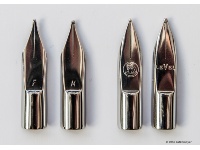
Stainless steel nibs (left) Level 65
and (right) Level L5 black
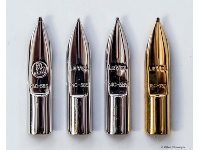
Rhodium-plated 14 ct gold nibs
and 18 ct gold nibs of the Level L5
Nibs from 1998 until today
M any more new filler series have now been equipped with stainless steel nibs of the same style as the GO! series. These include ![]() learn-to-write pens, pens for
learn-to-write pens, pens for ![]() youngsters and
youngsters and ![]() school and for
school and for ![]() adults as the model series Future P55/P56 (1998), Pelikan junior P65/P66 (from 2001) and P67/P68 (from 2005), Factor P40 (>2004), the Youth Filler Gallery P23 (from 2005), Grand Prix P459 (2006), Style P57/P58 (2007), Griffix (from 2010), th.INK P63 (2012) and Twist P457 (2013). Also all
adults as the model series Future P55/P56 (1998), Pelikan junior P65/P66 (from 2001) and P67/P68 (from 2005), Factor P40 (>2004), the Youth Filler Gallery P23 (from 2005), Grand Prix P459 (2006), Style P57/P58 (2007), Griffix (from 2010), th.INK P63 (2012) and Twist P457 (2013). Also all ![]() Pelikano models P460/P461 (2003) and P480/P481 (2010 to present) used this new stainless steel nib.
Pelikano models P460/P461 (2003) and P480/P481 (2010 to present) used this new stainless steel nib.
The nibs are available in widths F, M and B. Furthermore, the fountain pens are available for learning to write with A or L -nib.
For the new >series ![]() calligraphy Script P52/P53 corresponding nibs with widths of 1.0mm, 1.5mm and 2.0mm were manufactured.
calligraphy Script P52/P53 corresponding nibs with widths of 1.0mm, 1.5mm and 2.0mm were manufactured.
In 2006, the series ![]() Pura P40 came on the market, then four years later, the
Pura P40 came on the market, then four years later, the ![]() Dion P42. Both models were equipped with stainless steel nibs, corresponding to the style of the nib of the level L5, but unlinke these nibs have a round air hole.
Dion P42. Both models were equipped with stainless steel nibs, corresponding to the style of the nib of the level L5, but unlinke these nibs have a round air hole.
Another feature are the nibs of the series ![]() Happy Pen P24, which first came on the market in 2004. The basic shape corresponds to the simple steel nibs since 2008. These nibs have no iridium point, but only a folded tip.
Happy Pen P24, which first came on the market in 2004. The basic shape corresponds to the simple steel nibs since 2008. These nibs have no iridium point, but only a folded tip.
For a good exchange the forum The Fountain Pen Network - FPN.


